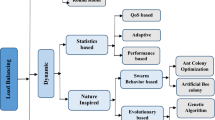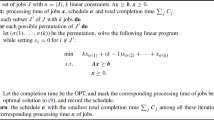Abstract
Real-time systems are increasingly appearing in complex and dynamic environments such as cruise controllers, life support systems and nuclear reactors. These systems contain components that sense, control and stabilize the environment towards achieving the mission or target. These consociate components synchronize, compute and control themselves locally or have a centralized component to achieve their mission. Distributed computing techniques improve the overall performance and reliability of large real-time systems with spread components.
Partially Clairvoyant scheduling was introduced in Saksena, M., PhD thesis (1994) to determine the schedulability of hard real-time jobs with variable execution times. The problem of deciding the Partially Clairvoyant schedulability of a constrained set of jobs was well studied in Gerber, R., et al., IEEE Trans. Comput. 44(3), 471–479 (1995), Choi, S. and Agrawala, A.K., Real-Time Syst. 19(1), 5–40 (2000), Subramani, K., J. Math. Model. Algorithms 2(2), 97–119 (2003). These algorithms determine the schedulability of a job-set offline and produce a set of dispatch functions for each job in the job-set. The dispatch functions of a job depend on the start and execution times of the jobs sequenced before the job. The dispatching problem is concerned with the online computation of the start time interval of a job such that none of the constraints are violated. In certain situations, the dispatcher fails to dispatch a job as it takes longer to compute the interval within which the job has to be dispatched, this phenomenon is called Loss of Dispatchability. For a job-set of size n, sequential approaches using function lists suffer from two major drawbacks, viz., Ω(n) dispatching time and the Loss of Dispatchability phenomenon. Existing approaches to this problem have been along sequential lines, through the use of stored function lists.
In this paper, we propose and evaluate three distributed dispatching algorithms for Partially Clairvoyant schedules. For a job-set of size n, the algorithms have dispatch times of O(1) per job. In the first algorithm, one processor executes all the jobs and other processors compute the dispatch functions. This scenario simplifies design and is better in situations where one processor controls all other devices. In the other algorithms, all the processors execute jobs pre-assigned to them and compute the dispatch functions; which is a plausible scenario in distributed controlling.
Similar content being viewed by others
References
Aydin, H., Melhem, R., Mossé, D., Mejía-Alvarez, P.: Dynamic and aggressive scheduling techniques for power-aware real-time systems. In: The 22nd IEEE Real-Time Systems Symposium (RTSS ’01), Washington–Brussels–Tokyo, December 2001, pp. 95–105. IEEE
Brinkschulte, U., Bechina, A., Picioroaga, F., Schneider, E., Ungerer, T., Kreuzinger, J., Pfeffer, M.: A microkernel middleware architecture for distributed embedded real-time systems. In: The 20th IEEE Symposium on Reliable Distributed Systems (SRDS ’01), Washington–Brussels–Tokyo, October 2001, pp. 218–226. IEEE
Choi, S., Agrawala, A.K.: Dynamic dispatching of cyclic real-time tasks with relative timing constraints. Real-Time Syst. 19(1), 5–40 (2000)
Gerber, R., Pugh, W., Saksena, M.: Parametric dispatching of hard real-time tasks. IEEE Trans. Comput. 44(3), 471–479 (1995)
Högstedt, K., Carter, L., Ferrante, J.: On the parallel execution time of tiled loops. IEEE Trans. Parallel Distributed Comput. 14(3), 307–321 (2003)
Hull, D.L., Feng, W., Liu, J.W.-S.: Enhancing the performance and dependability of real-time systems. In: Proceedings of International Computer Performance and Dependability Symposium (IPDS’95), April 1995, pp. 174–182. IEEE Computer Society
Marti, P., Fuertes, J.M., Fohler, G., Ramamritham, K.: Improving quality-of-control using flexible timing constraints: metric and scheduling issues. In: Proceedings of the 23rd IEEE Real-Time Systems Symposium (RTSS’02), pp. 91–100. IEEE Computer Society (2002)
Mok, A.K., Lee, C.-G., Woo, H., Konana, P.: The monitoring of timing constraints on time intervals. In: Proceedings of the 23rd IEEE Real-Time Systems Symposium (RTSS’02), pp. 191–200. IEEE Computer Society (2002)
Rybski, P.E., Gini, M., Hougen, D.F., Stoeter, S.A., Papanikolopoulos, N.: A distributed surveillance task using miniature robots. In: Gini, M., Ishida, T., Castelfranchi, C., Johnson, W.L. (eds.) Proceedings of the First International Joint Conference on Autonomous Agents and Multiagent Systems (AAMAS’02), pp. 1393–1394. ACM (2002)
Rybski, P.E., Stoeter, S.A., Erickson, M.D., Gini, M., Hougen, D.F., Papanikolopoulos, N.P.: A team of robotic agents for surveillance. In: Sierra, C., Gini, M., Rosenschein, J.S. (eds.) Proceedings of the Fourth International Conference on Autonomous Agents, Barcelona, Catalonia, Spain, June 2000, pp. 9–16. ACM
Schuldt, H., Alonso, G., Beeri, C., Schek, H.-J.: Atomicity and isolation for transactional processes. ACM Trans. Database Syst. 27(1), 63–116 (2002)
Saksena, M.: Parametric scheduling in hard real-time systems. PhD thesis, University of Maryland, College Park (1994)
Schiebe, M., Pferrer, S. (eds.): Real-Time Systems Engineering and Applications, vol. 1. Kluwer (1992)
Stankovic, J.A., Spuri, M., Ramamritham, K., Buttazzo, G.C. (eds.): Deadline Scheduling for Real-Time Systems. Kluwer (1998)
Subramani, K.: Duality in the parametric polytope and its applications to a scheduling problem. PhD thesis, University of Maryland, College Park (2000)
Subramani, K.: A specification framework for real-time scheduling. In: Grosky, W.I., Plasil, F. (eds.) Proceedings of the 29th Annual Conference on Current Trends in Theory and Practice of Informatics (SOFSEM), Lecture Notes in Computer Science, vol. 2540, pp. 195–207. Springer (2002)
Subramani, K.: An analysis of partially clairvoyant scheduling. J. Math. Model. Algorithms 2(2), 97–119 (2003)
Subramani, K.: A comprehensive framework for specifying clairvoyance, constraints and periodicity in real-time scheduling. Comput. J. 48(3), 259–272 (2005)
Thomadakis, M.E., Liu, J.-C.S.: On the efficient scheduling of non-periodic tasks in hard real-time systems. In: Proc. 20th IEEE Real Time Systems Symp., Phoenix, AZ, December 1–3 (1999)
Yang, S.X., Guangfeng, Y., Meng, M.: Real-time collision-free path planning and tracking control of a nonholonomic mobile robot using a biologically inspired approach. In: Proceedings of Computational Intelligence in Robotics and Automation, pp. 113–118. IEEE Computer Society (2001)
Author information
Authors and Affiliations
Corresponding author
Rights and permissions
About this article
Cite this article
Subramani, K., Yellajyosula, K. & Osman, A. Distributed algorithms for partially clairvoyant dispatchers. Cluster Comput 11, 115–131 (2008). https://doi.org/10.1007/s10586-007-0027-6
Received:
Accepted:
Published:
Issue Date:
DOI: https://doi.org/10.1007/s10586-007-0027-6




